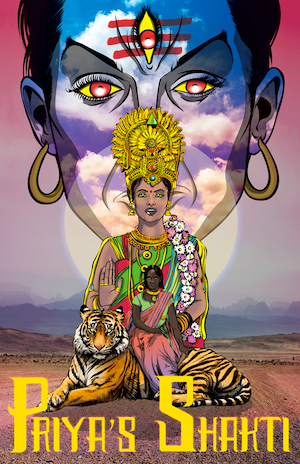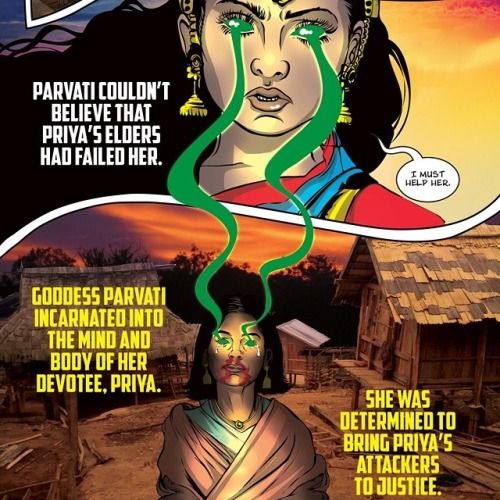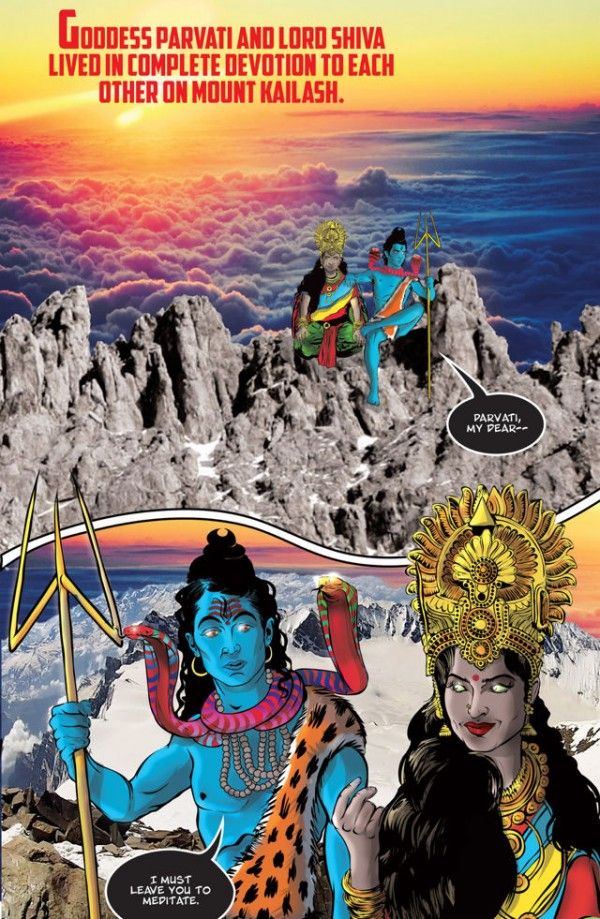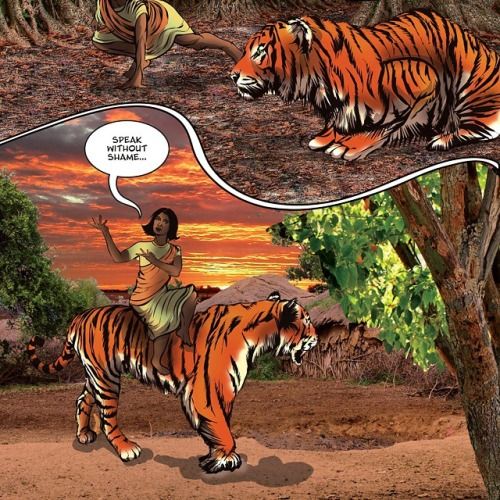Priya's Shakti is a comic that aims to change the world, or at least, one part of it.
The creation of writer Ram Devenini and artist Dan Goldman, Priya's Shakti uses elements of Indian religion and mythology to take on the difficult topic of rape and send a strong message that it's a crime and the victim is not to be blamed for it. The comic tells the story of a rape survivor who's cast out by her family, a situation that angers the gods; the resolution comes with a call to action.
The comic is available for free on comiXology and debuts in print this week at the Mumbai Film and Comics Convention. However, it's not limited by the usual distribution structures: As Devenini explains to ROBOT 6, the creators have partnered with the Indian charitable trust Apne Aap Women Worldwide to get the title out to girls in classrooms and communities far from comics shops. They also painted street murals in Mumbai that include an augmented reality feature; when viewed with a smart phone, parts of the murals are animated.
I spoke with Devenini and Goldman about making the comic, the special features, and how they plan to spread the word.
Brigid Alverson: What are you trying to accomplish with this comic? What do you hope people take away from it, or what action do you hope they will take?
Ram Devenini: I was in Delhi when the horrible gang rape happened on the bus in 2012, and was involved the protests that soon followed. Like many people, I was horrified by what had happened and angered by the indifference exhibited by government authorities at every level. There was an enormous outcry in particular from young adults and teenagers — both women and men. At one of the protests, my colleague and I spoke to a Delhi police officer and asked him for his opinion on what had happened on the bus. Basically, the officer’s response was that “no good girl walks home at night,” implying that she probably deserved it, or at least provoked the attack. I knew then that the problem of sexual violence in India was not a legal issue; rather it was a cultural problem. A cultural shift had to happen especially views towards the role of women in modern society. Deep-rooted patriarchal views needed to be challenged.
For about a year, I traveled around India and Southeast Asia learning from poets, philosophers, activists, and sociologists working for NGOs [non-governmental organizations] focused on gender-based violence. Talking with several rape survivors, I realized how difficult it was for them to seek justice and how much their lives were constantly under threat after they reported the crime. Their family, local community and even the police discouraged them from pursuing criminal action against their attackers. The burden of shame was placed on the victim and not the perpetrators. This created a level of impunity among men to commit more rapes.
Who is your target audience? Men, women, old, young, urban, rural?
Devenini: Our main audience is teenagers in India and around the world. India’s population is very young. Nearly half the population is under 25 years old, and they are the main audience for our comic book. Although our goal is to eventually reach wider audiences, we have chosen to initially focus on a huge demographic who we believe will be very receptive to both the message and the format of the comic. We plan to release it at the Mumbai and New Delhi Comic Cons and develop partnerships with cafe chains and retail outlets where teenagers and young adults hangout.
Why did you choose to tell a story to make your point, and why did you choose comics as the medium?
Devenini: I selected the comic book format because I grew up reading Amar Chitra Katha comic books and was hugely influenced by them. I think millions of children have read the series, and they’ve entered the collective consciousness of contemporary Indian culture. Often, I first learned about Hindu mythology through their comic book series. Also, comics are an important part of our culture, and hugely popular with teenagers and young adults. Now, comic books have entered the commercial mainstream. Every summer, Hollywood releases huge budget blockbuster films based on comic book characters to enormous box office returns. Comic book characters like Superman, Batman and Wonder Woman have become modern mythological icons, and other comic book stories such as Art Spiegelman’s Maus address important historical events. We are using existing constructs that are familiar to everyone in India, but presenting them in a fresh and original way.
Can you talk a bit about the intersection of comics and religion in India?
Ram Devenini: The most popular series is published by Amar Chitra Katha, which I talk about in the previous question. There are many comic books that use or directly tell the story of Hindu mythology, but I felt many of the new versions have been too by “Bollywood” or even “Hollywood” — meaning the characters are too “buffed” or too “sexualized.” I like the approach we took and also what Dan took. Of course, it has a retro feel to it, but the characters seems authentic and relatable.
In Hindu mythology, I discovered the many rich stories involving regular people and the gods. Often a favorite disciple would call on the gods for help during dire situations. So, I began formulating a new mythological tale where a mortal woman and rape survivor would seek help from the goddess Parvati — only after she had nowhere else to turn. Although Lord Shiva and other gods get involved, eventually it is up to her to challenge people’s perceptions. I wanted to create a new Indian “superhero” — Priya, who is a rape survivor and through the power of persuasion she is able to motivate people to change.
In my opinion, the core essence of Hinduism is about conquering your fears. In the story, Priya confronts the tiger that has been stalking her. She turns her fear, the tiger, in to her power — her shakti. Lastly, all mythological tales are about a hero over-coming obstacles to discover their role in the universal, and at the essence this is Priya’s journey. Also mythology is the story of us.
Is Priya's Shakti based on any particular story from Hindu tradition?
Devenini: No, it is a completely made up story. But, we have used common motifs in Hindu mythology. Especially villagers or common people calling on the gods for help during dire situations. I thought what is a direr situation than the problem of sexual violence in India, so it is only right that Priya call on the gods. But, in the end it is her who changes everything.
How did you come to work with Dan Goldman on this project?
Devenini: I met Dan Goldman at a StoryCode Meet-up in New York City, and literally hit it off on the spot. I think he signed on the next day. Dan is a remarkable artist and philosopher — he has brought a new perspective and look to the Hindu gods. His design is based on deep respect and affection for Hindu mythology and the power of the image. Each page is a stand-alone painting that can be mounted in a gallery.
Dan, what challenges did this present to you as an artist? Were you familiar with Indian comics before you started this project? How did you adapt your style?
Dan Goldman: Mostly it was fidelity. Working in a thousands-year-old religious and cultural milieu isn't something I took lightly, and I wanted to show the proper respect... but at the same time, leaving my mark on it.
So there was a balance there, and it took lots of reading and drinking up influences before I felt like what was coming out lined up with how I was seeing it in my mind's eye. Getting the relationships and who's present in the celestial sequences involved a lot of quick brush-up on Hindu mythos, and as we all know, comics are ideal for that. I tore through stacks of classic Amar Chitra comics about those tales; some I was familiar with from my travels in the U.K. (I bought these at every opportunity) and some I got from Ram when he came back from trips.
The story is very visual: How did the two of you collaborate? Was the comic entirely scripted before Dan started working on it?
Devenini: Yes, we scripted the comic book before we gave it to Dan, but it went through several revisions as Dan was working on it. For Vikas K. Menon and I, this is our first comic book, so we had to reduce a lot of language and allow the images to tell more of the story. Also, Joan Hilty played a big part in helping to edit it.
Goldman: I worked off Ram and Vikas Menon's script but it was evolving even after I'd finished the book, and we went back in to tweak things for a while. Our collaboration involved those tweaks and a weekly updates I'd send to the group to make sure my "India" was on point historically, culturally, religiously, etc. The script also passed through several other pairs of eyes before it got to me, for GBV (gender-based violence) sensitivity and cultural fidelity. This process saved me a lot of embarrassments as I definitely wanted the visuals to feel "of India."
What gave you the idea to do the murals in Mumbai? What are they of, and how do they relate to the comic?
Devenini: The idea for street art and murals came from my trip to Italy to research fresco art in relation to the comic book. It was when I spent time in the Sistine Chapel did the idea of public art and augmented reality fully comes to me. Also, I think mural and street art is a popular medium in India from political campaigns to marketing. But, often things get lost in the constant noise of the environment. We want the image of “Priya sitting on the Tiger” to be the iconic image for women fighting gender-based violence around the world. By having her image on public walls, we want it to resonate with people. Obviously there is a lot of metaphors and symbols in the image — similar to the goddess Durga sitting on a tiger. And Priya means “beloved.”
The murals are currently in Mumbai, but we are planning some in other cities, including Delhi. Our goal is to paint hundreds of them all over India and in other cities in other countries. We hire local artists and work with the community.
Augmented reality is a major part of our comic book, and by scanning the comic book with the popular augmented reality app, Blippar, you can view animation, real-life stories, and other interactive elements pop-out of the pages and walls.
The press release mentioned the NGO Apne Aap Women Worldwide. What part do they play in this?
Devenini: Apne Aap is our main outreach partner and will help get it into communities and schools. They have a long history dealing with this issue and will make sure the comic book will be used properly for social activism and change.
How are you distributing the comic?
Devenini: The comic book is currently available for free on all formats, including comiXology. We are planning to do a print version, but do not have a release date or publisher yet. People can download the comic book at www.priyashakti.com.
As you are distributing the comic digitally as well as in print, and both the comic and the murals incorporate augmented reality features that require a smartphone app, can you talk about the use of smartphones in India? Are they widespread? Are they a popular platform for comics?
Devenini: Smartphones and phones in general are hugely popular and used. I think there is a 40 to 50 percent penetration rate of smart devices, so its easy to experience the augmented reality on the comic book and murals.
On a technological level, we believe the use of augmented reality will have a significant impact on readers in India who are not as familiar with this approach. There is a huge “WOW” factor when readers first experience augmented reality. Our comic book will be one of the first publications to use augmented reality in India, and can help define the new frontiers of integrating books, exhibitions, and public art with augmented reality. Blippar is our augmented reality partner and recently opened offices in India. They hope to make augmented reality as popular as Facebook, and believe it can quickly take hold in India—which has a high concentration of users with smart devices.
What are your plans for the future -- will there be more comics in this series?
Devenini: Yes, we are talking with Apne Aap on doing other stories where Priya tackles other gender-based violence issues in india and other countries. But, not specific script or story is done, yet.





